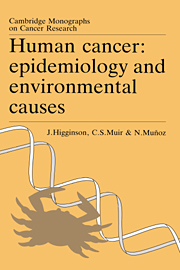Book contents
- Frontmatter
- Contents
- Contributors
- Preface
- Acknowledgements
- Historical introduction
- PART I Epidemiological methods
- PART II Causative factors in human cancer
- PART III Legal and ethical considerations
- PART IV Introduction: total and specific site epidemiology
- PART V Buccal cavity
- PART VI Digestive system
- PART VII Respiratory system
- PART VIII Bone and soft tissue
- PART IX Skin
- PART X Breast and genitourinary system
- PART XI Eye and nervous system
- PART XII Thyroid and other endocrine glands, lymphoid and hematopoietic system
- PART XIII Cancers in children and multiple primary cancers
- 58 Cancers in children
- 59 Multiple primary cancers: second cancers
- Conclusions
- Appendix 1 Cancer statistics
- Appendix 2 A glossary of epidemiological terms
- Appendix 3 Acronyms and abbreviations
- Supplement
- Index
59 - Multiple primary cancers: second cancers
Published online by Cambridge University Press: 03 May 2010
- Frontmatter
- Contents
- Contributors
- Preface
- Acknowledgements
- Historical introduction
- PART I Epidemiological methods
- PART II Causative factors in human cancer
- PART III Legal and ethical considerations
- PART IV Introduction: total and specific site epidemiology
- PART V Buccal cavity
- PART VI Digestive system
- PART VII Respiratory system
- PART VIII Bone and soft tissue
- PART IX Skin
- PART X Breast and genitourinary system
- PART XI Eye and nervous system
- PART XII Thyroid and other endocrine glands, lymphoid and hematopoietic system
- PART XIII Cancers in children and multiple primary cancers
- 58 Cancers in children
- 59 Multiple primary cancers: second cancers
- Conclusions
- Appendix 1 Cancer statistics
- Appendix 2 A glossary of epidemiological terms
- Appendix 3 Acronyms and abbreviations
- Supplement
- Index
Summary
Introduction
It has been known for many years that two or more independent primary tumors can arise in the same patient. Schoenberg (1977), who surveyed multiple cancers in Connecticut between 1935–1964, appears to have been the first to make a comprehensive quantitative analysis of the risk of developing a second tumor through the investigation of 120, 195 cancer patients from a well-defined population.
Second cancers may arise in the same individual for a number of reasons (Table 59.1). The major issue is usually whether an excess risk represents a common causal factor or some degree of genetic susceptibility. Among relevant issues are the following: (i) the recognition of syndromes of associated sites which may suggest a common etiology; (ii) identification of the regions of the body to which special attention should be paid when following up individuals with the first cancer; (iii) assessment of the carcinogenicity of treatments used for a first cancer.
Common etiological factors
The combined effects of tobacco and alcohol largely account for the constellation of cancers arising in the oral cavity, larynx and oesophagus. In contrast the association between retinoblastoma and osteosarcoma is most likely to reflect the influence of common hereditary factors. The interplay of both exogenous and endogenous factors in multiple cancers of the breast, uterine corpus, ovary and colon has long intrigued investigators. Both reproductive factors and dietary habits are believed to be involved. Biilow et al. (1990) report metachronous colorectal cancers can be as high as 30% after 40 years.
- Type
- Chapter
- Information
- Human CancerEpidemiology and Environmental Causes, pp. 493 - 496Publisher: Cambridge University PressPrint publication year: 1992
- 1
- Cited by

